

The W3C Markup Validation Service. XHTML Frequently Answered Questions. Editor: Steven Pemberton, W3C/CWI Version date: 21 July 2004 This Document is no longer maintained.

Other related FAQs: To comment on this document, or to send suggestions for questions, please email www-html-editor@w3.org, including the word FAQ in the subject. Why is XHTML needed? HTML is probably the most successful document markup language in the world. What are the advantages of using XHTML rather than HTML?
If your document is just pure XHTML 1.0 (not including other markup languages) then you will not yet notice much difference. If your document is more than XHTML 1.0, for instance including MathML, SMIL, or SVG, then the advantages are immediate: you can't do that sort of thing with HTML. Can I just put the XML declaration on top of existing HTML documents? No. What is the easiest way to convert my HTML documents to XHTML? HTML Tidy gives you the option to transform any HTML document into an XHTML one.
Why are browsers so fussy about XML? Einführung in XHTML, CSS und Webdesign - Michael Jendryschik. XHTML 1.0: The Extensible HyperText Markup Language (Second Edition) A Reformulation of HTML 4 in XML 1.0 W3C Recommendation 26 January 2000, revised 1 August 2002 superseded 27 March 2018 This version: Latest version: Previous version: Authors: See acknowledgments.
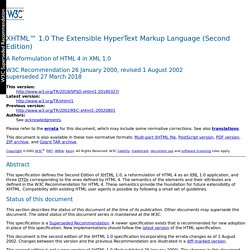
Please refer to the errata for this document, which may include some normative corrections. This document is also available in these non-normative formats: Multi-part XHTML file, PostScript version, PDF version, ZIP archive, and Gzip'd TAR archive. Copyright ©2002 W3C® (MIT, INRIA, Keio), All Rights Reserved. Abstract This specification defines the Second Edition of XHTML 1.0, a reformulation of HTML 4 as an XML 1.0 application, and three DTDs corresponding to the ones defined by HTML 4. Status of this document This section describes the status of this document at the time of its publication. This specification is a Superseded Recommendation. This document is the second edition of the XHTML 1.0 specification incorporating the errata changes as of 1 August 2002. XHTML 1.0: Die Extensible HyperText Markup Language (Zweite Auflage) - 1 Was ist XHTML? Eine Neuformulierung von HTML in XML 1.0 W3C-Empfehlung, 26.
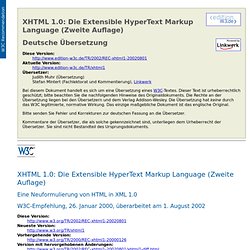
Januar 2000, überarbeitet am 1. August 2002. XHTML™ Modularization 1.1 - Second Edition. W3C Recommendation 29 July 2010.
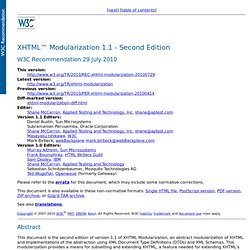
Modularisierung von XHTML. Die englische Version dieser Spezifikation ist die einzige normative Version.
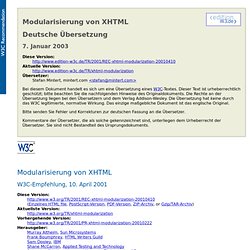
Informationen über Übersetzungen von diesem Text sind unter zu finden. Eine Liste aktueller W3C Recommendations und anderer technischer Dokumente befindet sich unter Dieser Abschnitt ist informell. XHTMLforum - Ein Forum für XHTML und CSS. Extensible Hypertext Markup Language. Vorlage:Infobox Dateiformat/Wartung/MagischeZahl fehltVorlage:Infobox Dateiformat/Wartung/Website fehlt Der W3C-Standard Extensible HyperText Markup Language (erweiterbare HTML; Abkürzung: XHTML) ist eine textbasierte Auszeichnungssprache zur Strukturierung und semantischen Auszeichnung von Inhalten wie Texten, Bildern und Hyperlinks in Dokumenten.

Es ist eine Neuformulierung von HTML 4.01 in XML: Im Gegensatz zu HTML, welche mittels SGML definiert wurde, verwendet XHTML die strengere und einfacher zu parsende SGML-Teilmenge XML als Sprachgrundlage. XHTML. XHTML (Extensible HyperText Markup Language) is a family of XML markup languages that mirror or extend versions of the widely used Hypertext Markup Language (HTML), the language in which web pages are written.
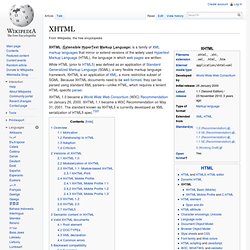
While HTML (prior to HTML5) was defined as an application of Standard Generalized Markup Language (SGML), a very flexible markup language framework, XHTML is an application of XML, a more restrictive subset of SGML. Because XHTML documents need to be well-formed, they can be parsed using standard XML parsers—unlike HTML, which requires a lenient HTML-specific parser. XHTML 1.0 became a World Wide Web Consortium (W3C) Recommendation on January 26, 2000. XHTML 1.1 became a W3C Recommendation on May 31, 2001. The standard known as XHTML5 is currently developed as XML serialization of HTML5 spec.[1][2] Overview[edit] However, in 2005, the Web Hypertext Application Technology Working Group (WHATWG) formed, independently of the W3C, to work on advancing ordinary HTML not based on XHTML.